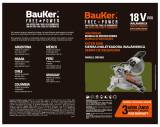
19 FRANÇAIS
10.
-
gez le réglage de l’angle de coupe en biseau ou
l’angle de coupe d’onglet, assurez-vous que le
guide réglable est placé correctement pour soutenir
la pièce et qu’il ne gênera pas la lame ou le disposi-
tif de protection.
et sans pièce sur la table, déplacez la lame de scie pour
qu’il n’y aura pas d’interférence ou de risque de couper
le guide.
11.
Prévoyez des supports adéquats comme des ral-
longes de table, un chevalet de sciage, etc., pour les
pièces plus larges ou plus longues que la table. Les
pièces plus longues ou plus larges que la table d’appui
de la scie radiale peuvent basculer si elles ne sont pas
solidement soutenues. Si la partie coupée de la pièce
ou la pièce elle-même bascule, elle peut soulever le
rotation.
12. Ne vous servez pas d’une autre personne à la
place d’une rallonge de table ou d’un support
supplémentaire. Un soutien instable de la pièce
peut pincer la lame ou faire bouger la pièce pen-
dant la coupe vous entraînant vous et votre assis-
tant vers la lame en rotation.
13.
La partie coupée de la pièce ne doit pas être coincée
ou appuyée par quelque moyen que ce soit contre la
lame de scie en rotation. Si elle est emprisonnée, au
moyen de butées longitudinales par exemple, la partie
coupée de la pièce risque de se coincer contre la lame
14. Utilisez toujours un dispositif de serrage ou
les pièces rondes comme les barres ou les
tuyaux. Les barres ont tendance à rouler pendant
la coupe, faisant « mordre » la lame et entraînant
la pièce et votre main sur la lame.
15. Attendez que la lame ait atteint sa pleine
vitesse avant de la mettre en contact avec la
pièce.
de la pièce.
16.
Si la pièce ou la lame se coince, mettez la scie
radiale hors tension. Attendez que toutes les pièces
du cordon d’alimentation de la prise secteur et/ou
retirez la batterie. Puis essayez de libérer la pièce
coincée. Si vous continuez à scier avec une pièce
coincée, vous risquez de perdre le contrôle de la scie
radiale ou de l’endommager.
17. Une fois la coupe terminée, relâchez l’interrup-
teur, tenez la tête de scie vers le bas et atten-
dez l’arrêt de la lame avant de retirer la partie
coupée de la pièce. Approcher votre main de la
lame « en roue libre » est dangereux.
18. Tenez fermement la poignée lorsque vous
faites une coupe incomplète ou lorsque vous
relâchez l’interrupteur avant d’avoir complè-
tement abaissé la tête de scie. Le freinage de la
scie peut tirer brusquement la tête de scie vers le
bas, ce qui présente un risque de blessure.
19. Utilisez uniquement une lame de scie ayant le
mode d’emploi. L’utilisation d’une taille incorrecte
le fonctionnement du carter de protection, ce qui
pourrait provoquer de graves blessures.
20. Utilisez uniquement des lames de scie sur
lesquelles est indiquée une vitesse égale ou
21. N’utilisez pas la scie pour couper autre chose
que du bois, de l’aluminium ou des matériaux
similaires.
22. (Pour les pays européens uniquement)
Utilisez toujours une lame conforme à la
norme EN847-1.
Instructions supplémentaires
1. Faites en sorte que l’atelier ne présente pas
de dangers pour les enfants en plaçant des
cadenas.
2. Ne vous tenez jamais debout sur l’outil. Vous
risqueriez de gravement vous blesser si l’outil
bascule ou si vous touchez par inadvertance l’outil
de coupe.
3. Ne laissez jamais sans surveillance un outil en
marche. Mettez-le hors tension. Attendez que
l’outil soit complètement arrêté avant de vous
éloigner.
4. N’utilisez jamais la scie sans les protecteurs
protecteur de lame avant chaque utilisation.
N’utilisez pas la scie si le protecteur de lame
ne se déplace pas librement et ne se referme
pas instantanément. N’immobilisez jamais le
protecteur de lame en position ouverte.
5. Gardez bien les mains à l’écart de la lame
de scie. Évitez tout contact avec une lame «
en roue libre ». Vous pourriez vous blesser
gravement.
6. Immobilisez toujours toutes les pièces mobiles
de l’outil avant de le transporter.
7. La broche d’arrêt qui verrouille en position
-
port et de rangement uniquement et pas pour
les opérations de coupe.
8.
ou de dommages sur les lames avant l’utili-
sation. Remplacez immédiatement les lames
et les copeaux de bois qui durcissent contre
augmentation des risques de choc en retour.
Pour nettoyer la lame, retirez-la d’abord de
l’outil, puis nettoyez-la avec un décapant, de
l’eau chaude ou du kérosène. N’utilisez jamais
d’essence pour nettoyer la lame.
9.
outil.
10.
Prenez garde de ne pas endommager l’alésage, les
-
lation) ou le boulon. Si ces pièces sont endomma-
gées, la lame peut se casser.
11. Assurez-vous que le socle rotatif est bien
déplacer pendant l’opération. Utilisez les
une plateforme de travail ou un établi stable.
N’utilisez JAMAIS l’outil si vous vous trouvez
dans une position incommode.
12. Assurez-vous que le blocage de l’arbre est
relâché avant de mettre la sous tension.




















